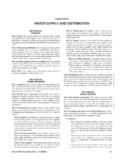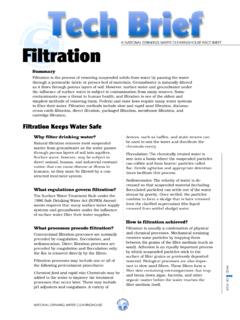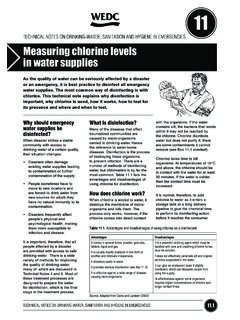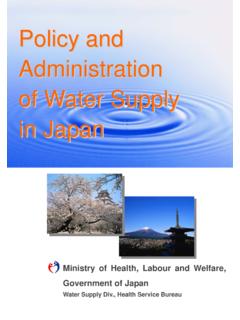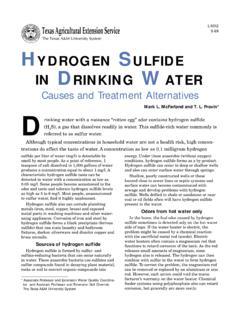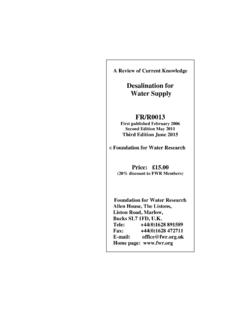Transcription of Nutrients in Drinking Water - World Health Organization
1 Nutrients in Drinking Water Water , Sanitation and Health Protection and the Human Environment World Health Organization Geneva WHO Library Cataloguing-in-Publication Data Nutrients in Drinking Water . 1. Water supply . 2. Potable Water . 3. Water treatment. 4. Nutrition. 5. Micronutrients. I. World Health Organization . ISBN 92 4 159398 9 (NLM classification: WA 687) World Health Organization 2005 All rights reserved. Publications of the World Health Organization can be obtained from WHO Press, World Health Organization , 20 Avenue Appia, 1211 Geneva 27, Switzerland (tel: +41 22 791 3264; fax: +41 22 791 4857; email: Requests for permission to reproduce or translate WHO publications whether for sale or for noncommercial distribution should be addressed to WHO Press, at the above address (fax: +41 22 791 4806.))
2 Email: The designations employed and the presentation of the material in this publication do not imply the expression of any opinion whatsoever on the part of the World Health Organization concerning the legal status of any country, territory, city or area or of its authorities, or concerning the delimitation of its frontiers or boundaries. Dotted lines on maps represent approximate border lines for which there may not yet be full agreement. The mention of specific companies or of certain manufacturers products does not imply that they are endorsed or recommended by the World Health Organization in preference to others of a similar nature that are not mentioned.
3 Errors and omissions excepted, the names of proprietary products are distinguished by initial capital letters. All reasonable precautions have been taken by WHO to verify the information contained in this publication. However, the published material is being distributed without warranty of any kind, either express or implied. The responsibility for the interpretation and use of the material lies with the reader. In no event shall the World Health Organization be liable for damages arising from its use. The named authors alone are responsible for the views expressed in this publication. Printed at the Printing and Binding Service WHO Geneva, Switzerland TABLE OF CONTENTS Preface.
4 I Acknowledgements .. iii 1. Nutrients IN Drinking Water - Consensus at Meeting .. 1 I. 1 II. Topics Examined in the 3 III. Drinking Water and Health Relationships .. 6 IV. Conclusions and Recommendations .. 10 2. DESALINATION GUIDELINES DEVELOPMENT FOR Drinking Water BACKGROUND (Joseph A. Cotruvo).. 13 I. 13 II. Drinking Water Production ..13 III. Desalination Technologies ..16 IV. 17 V. Distillation Technologies ..17 VI. Other Systems .. 18 VII. Potential Technical Issues Associated With 19 VIII. Petroleum IX. Conclusion .. 23 3. Water REQUIREMENTS, IMPINGING FACTORS AND RECOMMENDED INTAKES (Ann C. Grandjean).. 25 I. 25 II. Adverse Consequences of Inadequate Water Intake, Requirements for Water , and Factors that Affect 4.
5 ESSENTIAL Nutrients IN Drinking Water (Manuel Olivares & Ricardo Uauy).. 41 I. 41 II. Definition of Nutritional Requirements and 41 III. What are the Important Dietary Minerals and Electrolytes in the Diet and Potentially in Water that are Essential for Nutrition and Wellbeing? .. 43 IV. What are the RDAs for Minerals and Electrolytes and how are they determined? ..44 5. MINERALS FROM Drinking Water : BIOAVAILABILITY FOR VARIOUS World POPULATIONS AND Health IMPLICATIONS (Choon Nam Ong).. 61 I. 61 II. Studies in Asia .. 61 III. Studies in Pan-America ..63 IV. Studies in Africa .. 64 V. Studies in North VI.
6 Studies in Europe ..65 VII. Studies in the Western Pacific Region .. 68 VIII. Conclusion .. 68 6. THE CONTRIBUTION OF Drinking Water TO TOTAL DAILY DIETARY INTAKES OF SELECTED TRACE MINERAL Nutrients IN THE UNITED STATES (Joyce Morrissey Donohue, Charles O. Abernathy, Peter Lassovszky, George Hallberg).. 75 I. 75 II. Sources of Information ..76 III. Data and IV. 80 V. Conclusions .. 88 7. MINERAL ELEMENTS TO CARDIOVASCULAR Health (Leslie M. Klevay & Gerald F. Combs).. 92 I. 92 II. Nutritional Determinants of Heart Disease 92 III. Water and Heart Disease ..93 IV. Other Illnesses Related to Water Mineral Content.
7 93 V. Hardness Good or Softness Bad? .. 93 VI. Trace Elements in Water 94 VII. Conclusion .. 95 8. STUDIES OF MINERAL AND CARDIAC Health IN SELECTED POPULATIONS (Floyd J. Frost) .. 101 I. II. Magnesium III. Calcium, Copper, and Zinc Deficiencies ..103 IV. Magnesium, Strenuous Exercise, and Sudden Cardiac Death ..103 V. Conclusions ..103 9. HOW TO INTERPRET EPIDEMIOLOGICAL ASSOCIATIONS (Gunther F. Craun & Rebecca L. Calderon).. 108 I. II. Types of Epidemiological Studies ..109 III. The Exposure-Disease Association ..111 IV. Causality of an V. Web of Causation ..114 VI. Conclusions ..114 10. Water HARDNESS AND CARDIOVASCULAR DISEASE: A REVIEW OF THE EPIDEMIOLOGICAL STUDIES, 1957-78 (Rebecca L.)
8 Calderon & Gunther F. Craun)) .. 116 I. II. Scientific Reviews by Expert Groups ..116 III. Summary of the Epidemiological IV. Strength of Association ..121 V. Exposure-Response Relationship ..122 VI. Specificity of the Association ..122 VII. Reversibility ..122 VIII. Biological Plausibility ..123 IX. Conclusions ..123 11. Drinking Water HARDNESS AND CARDIOVASCULAR DISEASES: A REVIEW OF THE EPIDEMIOLOGICAL STUDIES, 1979-2004 (Silvano Monarca, Francesco Donato, Maria Zerbini) .. 127 I. II. Methods ..128 III. IV. V. Conclusions ..133 12. Health RISKS FROM Drinking DEMINERALISED Water (Frantisek Kozisek).
9 148 I. II. Health Risks from Consumption of Demineralised or Low-mineral Water ..150 III. Desirable Mineral Content of Demineralised Drinking Water ..155 IV. Guidelines and directives for calcium, magnesium, and hardness levels in Drinking Water ..157 V. Conclusions ..158 13. nutrient MINERALS IN Drinking Water : IMPLICATIONS FOR THE NUTRITION OF INFANTS AND YOUNG CHILDREN (Erika Sievers) 164 I. II. Assessment of Mineral Intake in infant III. The Quantitative Intake of Drinking Water in Infancy and early Childhood ..165 IV. The Contribution of Drinking Water to nutrient Mineral Intake in Infancy and Early Childhood ..169 V. Conclusions.
10 175 14. FLUORIDE (Michael Lennon, Helen Whelton, Dennis O'Mullane, Jan Ekstrand) .. 180 I. II. Fluoride Intake in III. Dental Effects of Ingested Fluoride ..181 IV. Ingested Fluoride and Health ..182 V. Implications of VI. Conclusion ..183 i PREFACE The World Health Organization assembled a diverse group of nutrition, medical and scientific experts in Rome in November 2003, at the WHO European Centre for Environment and Health , to address a number of questions relating to the nutrient composition of Drinking Water and the possibility that Drinking Water could in some circumstances contribute to total dietary nutrition. The original impetus of the meeting was as a contribution to development of Guidance on Health and environmental aspects of desalination that was initiated by the WHO Eastern Mediterranean Regional Office, and intended ultimately to contribute to the development of the 4th edition of the WHO Guidelines for Drinking Water Quality (GDWQ).










